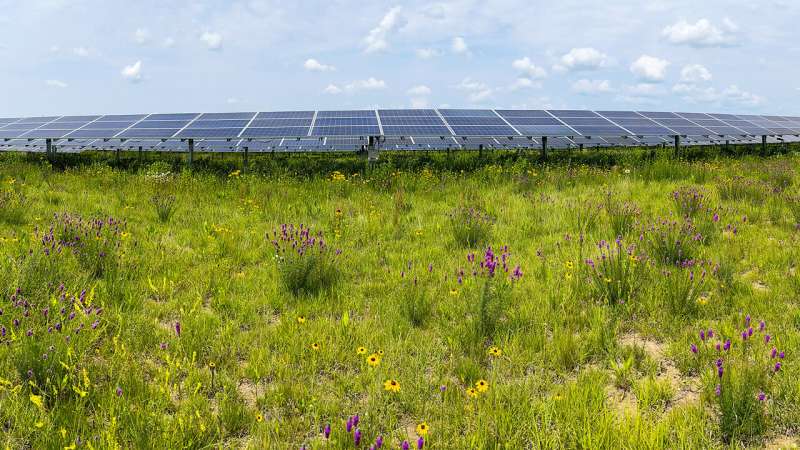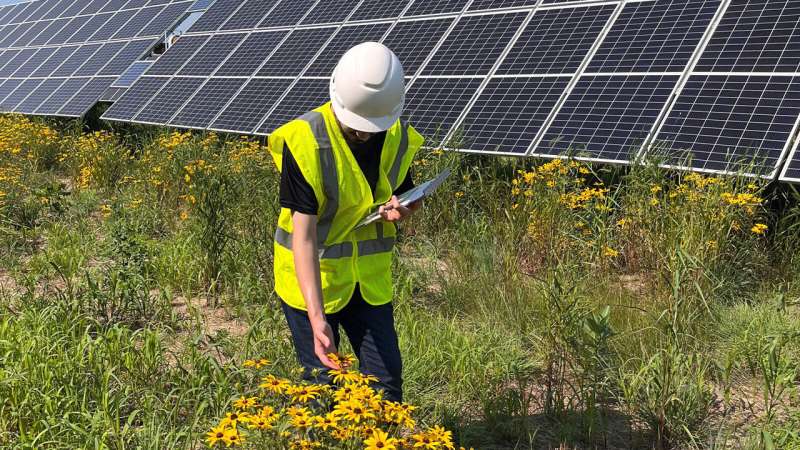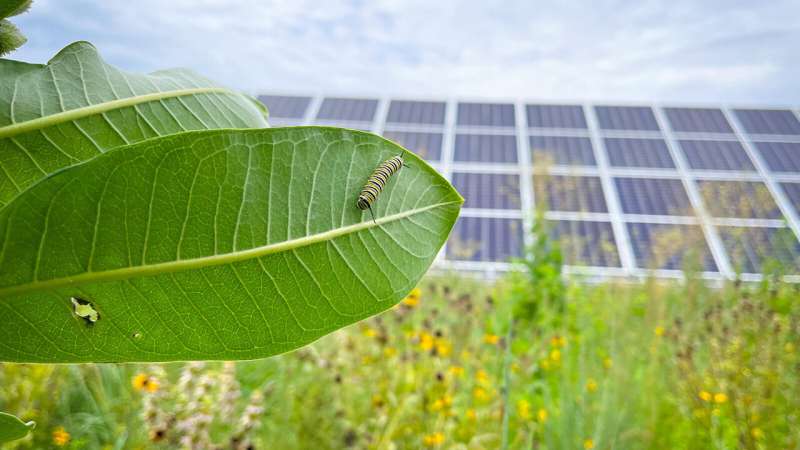This article has been reviewed according to Science X's editorial process and policies. Editors have highlighted the following attributes while ensuring the content's credibility:
fact-checked
peer-reviewed publication
trusted source
proofread
Insect populations flourish in the restored habitats of solar energy facilities

Bumblebees buzz from flower to flower, stopping for a moment under a clear blue Minnesota sky. Birds chirp, and tall grasses blow in the breeze. This isn't a scene from a pristine nature preserve or national park. It is nestled between photovoltaic (PV) solar arrays on rehabilitated farmland.
Researchers at the U.S. Department of Energy's (DOE) Argonne National Laboratory and National Renewable Energy Laboratory wanted to understand the ecological value of PV solar energy sites planted with native grasses and wildflowers. They examined how vegetation would establish and how insect communities would respond to the newly established habitat. The five-year field study published in Environmental Research Letters looked at two solar sites in southern Minnesota operated by Enel Green Power North America. Both sites were built on retired agricultural land.
Smart land use choices provide multiple benefits
Global insect biodiversity has been in decline due to habitat loss, pesticides and climate change. Restoration of insect habitat paired with smart land use changes toward renewable energy developments could help reverse the course.
For instance, as a carbon-neutral source of electricity, expanded PV solar energy development is critical to mitigating climate change. According to the DOE's Solar Futures Study, approximately 10 million acres of land in the U.S. will be needed for large-scale solar development by 2050 in order to meet grid decarbonization and climate change goals. But some lands are better suited for PV solar development than others. Disturbed lands such as former agricultural fields are ideal locations to hold rows of solar panels compared to lands that have been previously undisturbed.
Even more strategies can be added to this winning combination to support insect conservation. Agrivoltaics is the combination of solar energy production with agricultural and vegetation management practices. One type of agrivoltaics focuses on the establishment of habitat for insect pollinators and other wildlife that can provide important ecosystem services, such as pollination.
Pairing solar energy facilities on previously disturbed lands with habitat enhancement sounds like a logical win-win strategy to address energy and biodiversity challenges. To date, however, there has been little field data available to document the feasibility and the ecological benefits of this novel land use approach.

If you build it, will they come?
The two studied solar sites were planted with native grasses and flowering plants in early 2018. From August 2018 through August 2022, the researchers conducted 358 observational surveys for flowering vegetation and insect communities. They evaluated changes in plant and insect abundance and diversity with each visit.
"The effort to obtain these data was considerable, returning to each site four times per summer to record pollinator counts," said Heidi Hartmann, manager of the Land Resources and Energy Policy Program in Argonne's Environmental Sciences division, and one of the study's co-authors. "Over time we saw the numbers and types of flowering plants increase as the habitat matured. Measuring the corresponding positive impact for pollinators was very gratifying."
By the end of the field campaign, the team had observed increases for all habitat and biodiversity metrics. There was an increase in native plant species diversity and flower abundance. In addition, the team observed increases in the abundance and diversity of native insect pollinators and agriculturally beneficial insects, which included honeybees, native bees, wasps, hornets, hoverflies, other flies, moths, butterflies and beetles.
Flowers and flowering plant species increased as well. Total insect abundance tripled, while native bees showed a 20-fold increase in numbers. The most numerous insect groups observed were beetles, flies and moths.
In an added benefit, the researchers found that pollinators from the solar sites also visited soybean flowers in adjacent crop fields, providing additional pollination services.

The benefits of solar-pollinator habitats
"This research highlights the relatively rapid insect community responses to habitat restoration at solar energy sites," said Lee Walston, an Argonne landscape ecologist and environmental scientist who was lead author of the study. "It demonstrates, if properly sited, habitat-friendly solar energy can be a feasible way to safeguard insect populations and can improve the pollination services in adjacent agricultural fields." Walston also serves as head of the Ecology, Natural Resources, and Managed Systems department in Argonne's Environmental Science division.
The research findings suggest two important implications of habitat-friendly solar energy. One is that habitat-friendly solar sites can play an important role in conserving biodiversity. Large amounts of ground-mounted solar is expected to be developed in the future, but if properly sited, habitat-friendly solar can offset the losses of natural areas to provide biodiversity benefits.
Second, habitat-friendly solar sites can help mitigate land-use conflicts associated with the conversion of farmland for solar energy production. As approximately 80% of future ground-mounted solar development could occur on agricultural lands, the proper siting of habitat-friendly solar energy on marginal farmland can not only preserve prime farmland, but it could make prime farmland more productive through the pollination services provided by habitat-friendly solar energy.
Overall, additional research is needed to understand the feasibility of habitat-friendly solar across different regions and to meet different ecological goals such as conserving a target insect or wildlife species.
More information: Leroy J Walston et al, If you build it, will they come? Insect community responses to habitat establishment at solar energy facilities in Minnesota, USA, Environmental Research Letters (2023). DOI: 10.1088/1748-9326/ad0f72
Journal information: Environmental Research Letters
Provided by Argonne National Laboratory




















